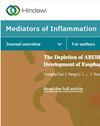系统性红斑狼疮并发早发性动脉粥样硬化的枢纽基因及发病途径探讨
IF 4.4
3区 医学
Q2 CELL BIOLOGY
引用次数: 0
摘要
背景。尽管越来越多的证据表明系统性红斑狼疮(SLE)加速动脉粥样硬化的进展,但这一现象的机制尚不完全清楚。本研究探讨了这种血管并发症背后的分子机制。方法。检索基因表达Omnibus数据库,获得SLE (GSE109248)和动脉粥样硬化(GSE100927)的基因表达数据集。通过R软件中的“limma”包筛选SLE和动脉粥样硬化的共有差异表达基因(DEGs),然后进行功能富集分析、蛋白-蛋白相互作用(PPI)网络构建、关键模块分析、枢纽基因选择、共表达分析。结果。在GSE109248和GSE100927中,共鉴定出1195和418个deg。随后,我们通过维恩图获得了表达趋势相同的78个共同deg(70个上调基因和8个下调基因)。最后,通过7种不同的算法在Cytohubba中鉴定出12个枢纽基因,包括PTPRC、TYROBP、FCGR3A、ITGAX、LCP2、IL1B、IRF8、LILRB2、CD68、C1QB、CCR7和C1QA。功能分析表明,这些基因主要富集于免疫和炎症反应、脂质和动脉粥样硬化以及骨质疏松症。这些结果提示SLE在诱导过度炎症中起重要作用,过度炎症可能由这些中枢基因介导,可诱发骨质疏松、体内正常矿物质平衡失衡以及脂质异常,最终导致动脉粥样硬化早发。总共鉴定出9个可能参与调节这些基因功能的转录因子(tf)。所有枢纽基因和4个tf均成功验证。结论。我们的研究结果表明SLE和动脉粥样硬化具有共同的DEGs、病理生理和枢纽基因。这些发现可以为进一步研究起作用的机制提供新的证据和见解。本文章由计算机程序翻译,如有差异,请以英文原文为准。
Exploration of Hub Genes and Pathogenetic Pathways in Systemic Lupus Erythematosus Complicated with Early Onset Atherosclerosis
Background. Notwithstanding the mounting evidence to suggest that systemic lupus erythematosus (SLE) accelerates the progression of atherosclerosis, the mechanisms underlying this phenomenon are yet to be completely understood. This research examined the molecular mechanism behind this vascular complication. Methods. The Gene Expression Omnibus database was retrieved to acquire the gene expression datasets for SLE (GSE109248) and atherosclerosis (GSE100927). The shared differentially expressed genes (DEGs) of SLE and atherosclerosis were screened with the help of the “limma” package in R software, followed by function enrichment analysis, protein–protein interaction (PPI) network construction, key module analysis, hub gene selection, and coexpression analysis. Results. In GSE109248 and GSE100927, 1195 and 418 DEGs in totals were identified, respectively. Subsequently, we acquired 78 common DEGs (70 upregulated genes and eight downregulated genes) with the same expression trends by using the Venn diagram. Finally, 12 hub genes, including PTPRC, TYROBP, FCGR3A, ITGAX, LCP2, IL1B, IRF8, LILRB2, CD68, C1QB, CCR7, and C1QA were identified by using seven different algorithms in Cytohubba. The functional analysis illustrates that these genes were predominantly enriched in immune and inflammation response, lipid and atherosclerosis, and osteoporosis. These results indicate an important role of SLE in inducing excessive inflammation, which may be medicate by these hub genes and can induce osteoporosis and imbalance of the normal mineral balance in the body as well as lipid abnormalities, which eventually leads to premature onset of atherosclerosis. In total, nine transcription factors (TFs) that may participate in regulating the function of these genes were identified. All hub genes and four TFs were validated successfully. Conclusion. The results of our research show that SLE and atherosclerosis have common DEGs, pathophysiology, and hub genes. These findings can provide fresh evidence and insights into a further investigation into the mechanisms at play.
求助全文
通过发布文献求助,成功后即可免费获取论文全文。
去求助
来源期刊

Mediators of Inflammation
医学-免疫学
CiteScore
8.70
自引率
0.00%
发文量
202
审稿时长
4 months
期刊介绍:
Mediators of Inflammation is a peer-reviewed, Open Access journal that publishes original research and review articles on all types of inflammatory mediators, including cytokines, histamine, bradykinin, prostaglandins, leukotrienes, PAF, biological response modifiers and the family of cell adhesion-promoting molecules.
 求助内容:
求助内容: 应助结果提醒方式:
应助结果提醒方式:


